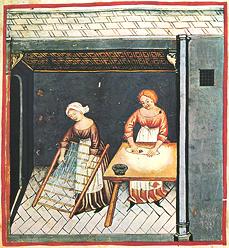
SAFARI
Users
General & History
The history of pasta and noodles is covered in detail on our pages Pasta & Noodles and Italian Pasta. Suffice to say here, real Pasta didn't come from China - dried noodles originated from the Arabs, and real pasta, made from hard winter wheat, probably originated from Sicily.
European pastas and noodles are all wheat based, except perhaps a few specialty items for the "gluten free" market.
Hungary
Instructions for making the fresh products shown below will be found at Hungarian Fresh Pasta.
Aproteszta- [211; Lebbencs Leves Teszta (Hungarian), Broad Noodles]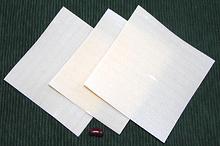
Not sure yet how these are used. The photo specimens were typically
4.5 inches square and 0.40 inch thick. Ingred: wheat flour, eggs.
Csiga Teszta- [212]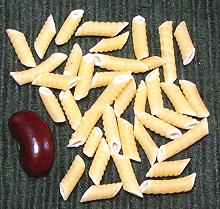 These are a screw shaped soup noodle. The photo specimens were
0.13 inch diameter and 0.53 inch randoms in length. Ingred: flour
and/or semolina, whole eggs.
These are a screw shaped soup noodle. The photo specimens were
0.13 inch diameter and 0.53 inch randoms in length. Ingred: flour
and/or semolina, whole eggs.
Csipetke- [034] These are used in stews, generally fresh, but they can be dried.
They are somewhat more substantial than Tarhonia. They are easy to
make, you just make a ball of dough and pinch off pieces, flattening
them between your fingers. Ingred: flour, egg, salt.
These are used in stews, generally fresh, but they can be dried.
They are somewhat more substantial than Tarhonia. They are easy to
make, you just make a ball of dough and pinch off pieces, flattening
them between your fingers. Ingred: flour, egg, salt.
Egg Noodles- [228] Fresh egg noodles are used in many Hungarian dishes. They are easy
to make. You just roll out a ball of dough as thin as you can get
it and cut into the size ribbons you want. They should dry for 1/2
hour before cooking. Ingred: flour, eggs, salt.
Fresh egg noodles are used in many Hungarian dishes. They are easy
to make. You just roll out a ball of dough as thin as you can get
it and cut into the size ribbons you want. They should dry for 1/2
hour before cooking. Ingred: flour, eggs, salt.
Galuska- [227] These dumplings are used in many Hungarian dishes, generally made
fresh. Making them is easy. A ball of dough is rolled out to about
1/2 inch thick, then the dumplings are cut off from it using a spoon
or some similar cutter. Ingred: flour, egg, salt.
These dumplings are used in many Hungarian dishes, generally made
fresh. Making them is easy. A ball of dough is rolled out to about
1/2 inch thick, then the dumplings are cut off from it using a spoon
or some similar cutter. Ingred: flour, egg, salt.
Today, smaller Galuska or Nokedli may be used, similar to the German
Späetzle. Incidently, the spoon method was an old method for
making späetzle in German homes, thus "späetzle" (little
sparrows). Well, that's one theory, anyway.
Szélesmetélt- [215; Broad Noodles]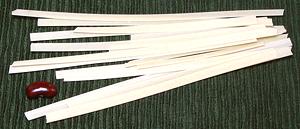 These are made of soft wheat flour, and are very fragile. The photo
specimens were typically 0.185 inch wide, 0.025 inch thick and 6.5
inches long. Ingred: flour, egg.
These are made of soft wheat flour, and are very fragile. The photo
specimens were typically 0.185 inch wide, 0.025 inch thick and 6.5
inches long. Ingred: flour, egg.
Tarhonia- [033; Rivilchas, Egg Barley]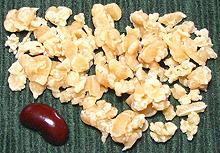
This is a very important noodle in Hungary. It was formally made by
families by the sack full, dried and stored for the winter. It is
used in soups, stews and with sauce. They are available commercially,
but better made at home. It's easy, you just make a ball of dough and
grate it on the coarse side of a box grater. The photo specimens show
freshly home made on the left, and packaged commercial on the right.
Ingred: flour, egg, salt.
|
Poland
The word for noodles in Polish is Iazanki, and they are quite popular there.
Polish Thin Egg Noodles- [213]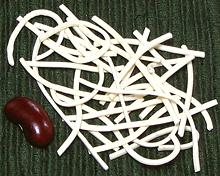
Labeled as Niteczki domowe (rolled macaroni) these are cut egg
noodles 0.55 x 0.45 inch by 1-3/4 inch randoms. The cook very fast,
3 to 4 minutes. Ingred: Flour 500 (all purpose flour), egg (4.8%),
water, curcuman (turmeric).
Polish Curls- [234]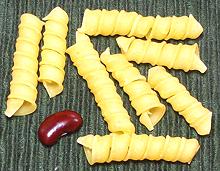 These are made of bread flour, so their cooking and eating properties
are more like egg noodles. The photo specimens were typically 0.380
inch diameter and 1.5 inch random lengths. Ingred: wheat flour
(Triticum aestivum), water, seasoning. I suspect the
seasoning is turmeric for color, as egg is not indicated.
These are made of bread flour, so their cooking and eating properties
are more like egg noodles. The photo specimens were typically 0.380
inch diameter and 1.5 inch random lengths. Ingred: wheat flour
(Triticum aestivum), water, seasoning. I suspect the
seasoning is turmeric for color, as egg is not indicated.
Polish Dischi- [236]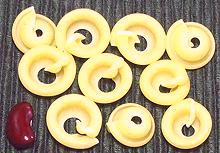 These are made with the standard Italian Dischi die, but are made
of bread flour, so their cooking and eating properties are more like
egg noodles. The photo specimens were typically 0.8 inch diameter.
Ingred: wheat flour (Triticum aestivum), water, seasoning.
I suspect the seasoning is turmeric for color, as egg is not indicated.
These are made with the standard Italian Dischi die, but are made
of bread flour, so their cooking and eating properties are more like
egg noodles. The photo specimens were typically 0.8 inch diameter.
Ingred: wheat flour (Triticum aestivum), water, seasoning.
I suspect the seasoning is turmeric for color, as egg is not indicated.
Polish Lasagnetti- [233]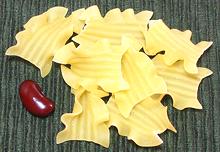 These are made with the standard Italian Lasagnetti die, but are made
of bread flour, so their cooking and eating properties are more like
egg noodles. The photo specimens were typically 0.32 inch thick,
0.75 inch wide and 1.5 inches long. Ingred: wheat flour
(Triticum aestivum), water, seasoning. I suspect the seasoning
is turmeric for color, as egg is not indicated.
These are made with the standard Italian Lasagnetti die, but are made
of bread flour, so their cooking and eating properties are more like
egg noodles. The photo specimens were typically 0.32 inch thick,
0.75 inch wide and 1.5 inches long. Ingred: wheat flour
(Triticum aestivum), water, seasoning. I suspect the seasoning
is turmeric for color, as egg is not indicated.
Polish Nuvole- [264] These are made with the standard Italian Nuvole die, but are made
of bread flour, so their cooking and eating properties are more like
egg noodles. The package suggests serving with cabbage and mushrooms,
but I'm sure they would go very well with a popular Polish dish of
noodles and cabbage with sour cream and garnished with butter fried
breadcrumbs. The photo specimens were typically 0.32 inch thick,
0.7 inch wide and 0.8 inch long. Ingred: wheat flour, water,
vitamin A.
These are made with the standard Italian Nuvole die, but are made
of bread flour, so their cooking and eating properties are more like
egg noodles. The package suggests serving with cabbage and mushrooms,
but I'm sure they would go very well with a popular Polish dish of
noodles and cabbage with sour cream and garnished with butter fried
breadcrumbs. The photo specimens were typically 0.32 inch thick,
0.7 inch wide and 0.8 inch long. Ingred: wheat flour, water,
vitamin A.
Polish Squares- [337] I have no idea yet how these are used in Poland. The photo specimens
were typically 0.33 inch thick, 0.80 inch wide and 0.97 inch long.
Ingred: pasta flour, water, turmeric.
I have no idea yet how these are used in Poland. The photo specimens
were typically 0.33 inch thick, 0.80 inch wide and 0.97 inch long.
Ingred: pasta flour, water, turmeric.
Polish Half Culverts- [338]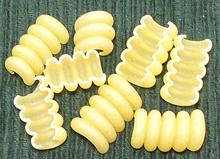 These resemble a half section of corrigated steel culvert piping.
They cooked well, and with this shape, they are very good at holding
sauces. The photo specimens were typically 0.33 inch thick, 0.97 inch
long and 0.54 inch wide. Ingred: pasta flour, water, turmeric.
These resemble a half section of corrigated steel culvert piping.
They cooked well, and with this shape, they are very good at holding
sauces. The photo specimens were typically 0.33 inch thick, 0.97 inch
long and 0.54 inch wide. Ingred: pasta flour, water, turmeric.
|
Lithuania
Egg Noodle Shapes- [330]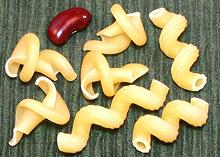 Lithuania is currently exporting egg noodle shapes to North America,
both short and long shapes. Like their neighbors, the Poles, these
shapes are made with traditional Italian dies, but are egg noodles
rather than duram wheat pasta. Egg noodles are much more popular in the
region and work well with the sauces used there (primarily butter
and sour cream). Those I've tried have been of very high quality and
hold together well in cooking. The tubular one is cellentini.
I haven't identified the Italian die for the other, but it looks
like a mushroom. It is a particularly good shape with just butter,
salt and pepper.
Lithuania is currently exporting egg noodle shapes to North America,
both short and long shapes. Like their neighbors, the Poles, these
shapes are made with traditional Italian dies, but are egg noodles
rather than duram wheat pasta. Egg noodles are much more popular in the
region and work well with the sauces used there (primarily butter
and sour cream). Those I've tried have been of very high quality and
hold together well in cooking. The tubular one is cellentini.
I haven't identified the Italian die for the other, but it looks
like a mushroom. It is a particularly good shape with just butter,
salt and pepper.
|
Germany
Späetzle- [323]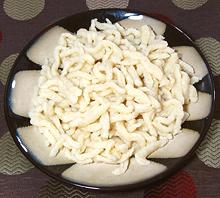 This is the pasta of Germany. It is properly made fresh, squeezed
through the holes of a späetzle maker directly into boiling
water, but some is made dried for sale in North America. Those
shown in the photo, typically 0.25 inch diameter randoms, are direct
from the cold water quench. They are then fried in butter, either to
just warm, or lightly browned. See our recipe
Späetzle recipe
for all the details.
This is the pasta of Germany. It is properly made fresh, squeezed
through the holes of a späetzle maker directly into boiling
water, but some is made dried for sale in North America. Those
shown in the photo, typically 0.25 inch diameter randoms, are direct
from the cold water quench. They are then fried in butter, either to
just warm, or lightly browned. See our recipe
Späetzle recipe
for all the details.
Bandnudeln- [262]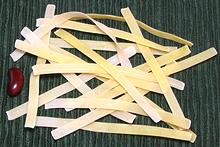 These standard medium egg noodles are exactly what you'd expect from
well made egg noodles, though made by the same company that made those
strange Spiralnudln described below. The photo specimens were
typically 3.25 inches long, 0.22 inch wide and 0.030 inch thick.
Ingred: wheat flour, eggs (20%), water.
These standard medium egg noodles are exactly what you'd expect from
well made egg noodles, though made by the same company that made those
strange Spiralnudln described below. The photo specimens were
typically 3.25 inches long, 0.22 inch wide and 0.030 inch thick.
Ingred: wheat flour, eggs (20%), water.
Egg Noodles, Extra Broad- [239]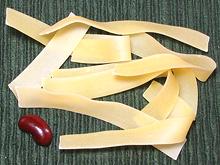 These noodles are actually egg pasta, made out of durum wheat. As
such they have a firmer, less elastic texture and a less sweet taste
than regular egg noodles. The photo specimens were typically 3 inches
long, 0.43 inch wide and 0.035 inch thick. Ingred: durum wheat
semolina, eggs.
These noodles are actually egg pasta, made out of durum wheat. As
such they have a firmer, less elastic texture and a less sweet taste
than regular egg noodles. The photo specimens were typically 3 inches
long, 0.43 inch wide and 0.035 inch thick. Ingred: durum wheat
semolina, eggs.
Egg Noodles, Thin Soup- [240]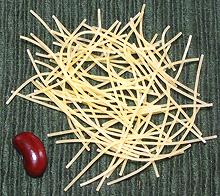 These noodles are actually egg pasta, made out of durum wheat. As
such they have a firmer, less elastic texture and a less sweet taste
than regular egg noodles. These are very similar to Italian rotini.
The photo specimens were typically 2-1/2 inch random lengths and
0.035 inch thick. Ingred: durum wheat semolina, eggs.
These noodles are actually egg pasta, made out of durum wheat. As
such they have a firmer, less elastic texture and a less sweet taste
than regular egg noodles. These are very similar to Italian rotini.
The photo specimens were typically 2-1/2 inch random lengths and
0.035 inch thick. Ingred: durum wheat semolina, eggs.
Rotini with Egg- [238] These noodles are actually egg pasta, made out of durum wheat.
The photo specimens were typically 0.325 inch diameter and 1.75
inches long. Ingred: durum wheat semolina, eggs.
These noodles are actually egg pasta, made out of durum wheat.
The photo specimens were typically 0.325 inch diameter and 1.75
inches long. Ingred: durum wheat semolina, eggs.
Spiralnudeln- [243]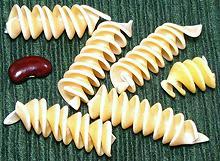 These are definitely one of the strangest noodles I've encountered.
Long before they are done, the outer edge of the fins has separated
into a fine thread, intertangled with the spiral. By time the spiral
is done, these threads are badly overcooked. Is this accidental, or
an example of German pasta engineering gone bonkers? The photo
specimens were typically 0.5 inch diameter and 1.8 inches long.
Although in the standard rotini pasta form, they are actually egg
noodles made of bread flour, and have the taste and texture of egg
noodles. Ingred: wheat flour, eggs (20%), water.
These are definitely one of the strangest noodles I've encountered.
Long before they are done, the outer edge of the fins has separated
into a fine thread, intertangled with the spiral. By time the spiral
is done, these threads are badly overcooked. Is this accidental, or
an example of German pasta engineering gone bonkers? The photo
specimens were typically 0.5 inch diameter and 1.8 inches long.
Although in the standard rotini pasta form, they are actually egg
noodles made of bread flour, and have the taste and texture of egg
noodles. Ingred: wheat flour, eggs (20%), water.
German Funghetti- [342]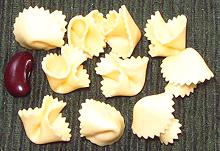 In the shape of little mushrooms, these noodles are actually egg
pasta, made out of durum wheat. They cook very well, but have a
somewhat smoother, more resilient bite. They are somewhat larger
than Italian Funghetti I have found to date.
The photo specimens were typically 0.75 inch diameter and 0.60
inch high. Ingred: durum wheat semolina, cage free eggs.
In the shape of little mushrooms, these noodles are actually egg
pasta, made out of durum wheat. They cook very well, but have a
somewhat smoother, more resilient bite. They are somewhat larger
than Italian Funghetti I have found to date.
The photo specimens were typically 0.75 inch diameter and 0.60
inch high. Ingred: durum wheat semolina, cage free eggs.
Little Pockets- [359]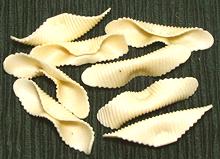 These noodles are actually egg pasta, made out of durum wheat and
cage-free eggs. They cook very well, but have a somewhat smoother,
more resilient bite than Italian pasta. The photo specimens were
typically 1.97 inches long (5 cm). Product of Germany - durum wheat
semolina, cage free eggs.
These noodles are actually egg pasta, made out of durum wheat and
cage-free eggs. They cook very well, but have a somewhat smoother,
more resilient bite than Italian pasta. The photo specimens were
typically 1.97 inches long (5 cm). Product of Germany - durum wheat
semolina, cage free eggs.
|
France
Macaronade- [214]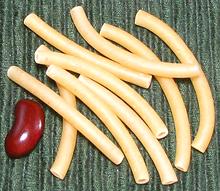 These long macaronis were made in Provence, France, which is where
they are traditional, often served with beef that has been stewed in
red wine. Hollow tubes 0.165 inch diameter, 2 inch random lengths.
Ingred: durum wheat.
These long macaronis were made in Provence, France, which is where
they are traditional, often served with beef that has been stewed in
red wine. Hollow tubes 0.165 inch diameter, 2 inch random lengths.
Ingred: durum wheat.
This pasta can be very hard to find in North America. When I can't
replenish my supply I break up Mezzanelli into 2 inch lengths. It's
0.175 inch diameter, so it's only 1/100th inch larger, but it is
straight rather than curved. When I can't find that either, I use
Greek Pastichio (the large size - see below), which is identical.
|
Greece
Orzo, for soup and salad, and Pastitsio for oven baked dishes dominate pasta usage in Greece, but some other Italian style shapes are also used. As in Turkey, the Greeks like their pasta cooked all the way through rather than al dente. Not mushy, mind you, but with no stiff center.
Orzo, Large- [287]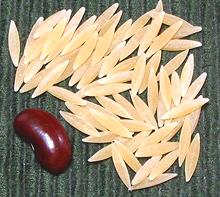 Orzo is a very popular pasta in Greece due to its use in many
salads. The photo specimens were 0.48 inch long, 0.090 inch wide and
0.090 inch thick. A bit longer and narrower than our Italian specimens.
Orzo is a very popular pasta in Greece due to its use in many
salads. The photo specimens were 0.48 inch long, 0.090 inch wide and
0.090 inch thick. A bit longer and narrower than our Italian specimens.
Pastitsio - small- [237 Pastichio] These are used for making the popular Greek dish pastitsio,
though the larger size (#327) may be preferred. This pasta is pretty
much identical to the Italian bucatini. The photo specimens, Monastiri
brand, were 10 inches long, 0.11 inches diameter and hollow. Ingred:
durum wheat semolina.
These are used for making the popular Greek dish pastitsio,
though the larger size (#327) may be preferred. This pasta is pretty
much identical to the Italian bucatini. The photo specimens, Monastiri
brand, were 10 inches long, 0.11 inches diameter and hollow. Ingred:
durum wheat semolina.
Pastitsio - large- [327 Pastichio] These are, I believe, the preferred pasta for use in making the popular
Greek dish pastitsio, though larger tubular pastas are
often substituted. That the entire package was in Greek with no
English or Italian suggests authenticity. They are pretty much
identical to the Italian Mezzanelli and Regine. The photo specimens,
Misko brand, were 10 inches long, 0.175 inches diameter and hollow.
Ingred: durum wheat semolina.
These are, I believe, the preferred pasta for use in making the popular
Greek dish pastitsio, though larger tubular pastas are
often substituted. That the entire package was in Greek with no
English or Italian suggests authenticity. They are pretty much
identical to the Italian Mezzanelli and Regine. The photo specimens,
Misko brand, were 10 inches long, 0.175 inches diameter and hollow.
Ingred: durum wheat semolina.
|
Romania
Corn Spaghetti- [289] I don't know how popular corn pasta actually is in Rumania, but it is
definitely made there. This spaghetti was "private label" packaged
for Trader Joes as one of their "gluten free" offerings. Cooked, it
was more like regular wheat pasta than I expected. Of course, both
flavor and texture were a little different. The package says to cook
"for 8 minutes or until desired tenderness". I found desired
tenderness at about 15 minutes. The photo specimens were 10.2 inches
long a 0.070 inch diameter. Ingred: corn flour, water.
I don't know how popular corn pasta actually is in Rumania, but it is
definitely made there. This spaghetti was "private label" packaged
for Trader Joes as one of their "gluten free" offerings. Cooked, it
was more like regular wheat pasta than I expected. Of course, both
flavor and texture were a little different. The package says to cook
"for 8 minutes or until desired tenderness". I found desired
tenderness at about 15 minutes. The photo specimens were 10.2 inches
long a 0.070 inch diameter. Ingred: corn flour, water.
Corn Penne- [331]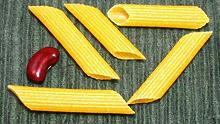 Again, I don't know how popular corn pasta actually is in Rumania,
but it is definitely made there. This penne was "private label"
packaged for Trader Joes as one of their "gluten free" offerings.
Cooked, it was more like regular wheat pasta than I expected. Of
course, both flavor and texture were a little different. The package
says to cook "for 8 minutes or until desired tenderness". I found
desired tenderness at about 15 minutes. The photo specimens were 2.0
inches long a 0.33 inch diameter. Ingred: corn flour, water.
Again, I don't know how popular corn pasta actually is in Rumania,
but it is definitely made there. This penne was "private label"
packaged for Trader Joes as one of their "gluten free" offerings.
Cooked, it was more like regular wheat pasta than I expected. Of
course, both flavor and texture were a little different. The package
says to cook "for 8 minutes or until desired tenderness". I found
desired tenderness at about 15 minutes. The photo specimens were 2.0
inches long a 0.33 inch diameter. Ingred: corn flour, water.
|
Armenia
Until 2018, the only "Armenian" pasta easily available here in Los Angeles was the thin, cut "Vermicelli" used to make rice and pasta pilafs. It was very popular, and all the multi-ethnic markets stocked piles of it. In late 2018, a number of other Armenian pastas started to show up, and we have listed those here.
Vermicelli- [218; Tell Shehrich (Armenian)]
This form of pasta is very popular in Armenia, and has spread through
the Near East. The multi-ethnic markets here in Los Angeles are
heavily stocked with packages of this pasta due to high demand from
our large Armenian population, who use it for rice and vermicelli
pilafs. These pilafs were, in fact, the inspiration for creation of
the Rice-a-Roni product line by an Italian pasta making family. This
pasta is about 0.04 inch diameter, usually cut to about 0.9 inch
long. This is about the same thickness as Italian Capellini. Product
of USA.
Vermicelli, Toasted- [357]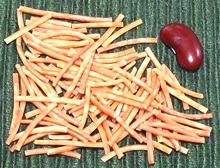
This is the same as the regular Vermicelli, but toasted. Toasted
pasta is very popular in Armenia. This pasta is about 0.06 inch
diameter, usually cut to about 0.9 inch long. Product of Armenia
Gyowgakan- [353]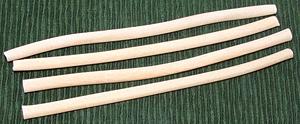
I suspect these tubular pastas are partially cooked and then
combined with vegetables and sauce in a casserole, similar to dishes
of medium tubular pastas in Greece and Turkey. 7 x 0.31 inches.
Product of Armenia - wheat flour, water, salt.
Tatar-Boraki- [354]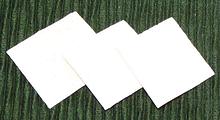
These are flat squares of pasta 1.2 x 1.2 x 0.05 inches. They are
cooked in water or broth, drained, and mixed with yogurt and garlic
or fried onions. Product of Armenia - wheat flour, water, salt.
Arishta- [355]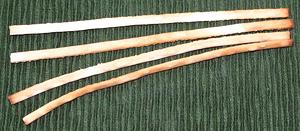
These are lightly toasted pasta sticks, 7 x 0.21 x 0.13 inches.
They are my favorite of the Armenian pastas I have tried. Product of
Armenia - wheat flour, water, salt.
Linguini, Toasted- [358]
These are very similar to the toasted noodles of the Levant, but
toasted quite a bit darker. 10-3/8 x 0.15 x 0.05. Product of Armenia -
wheat flour, water, salt.
Other Pasta Shapes- [356]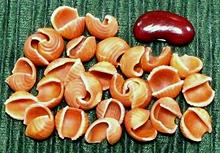
A number of Italian shapes, like these small shells, are also
toasted in Armenia. These were about 0.34 inch long. Product of
Armenia - wheat flour, water, salt.
|
Turkey
Turkish pasta usage is quite similar to that of Greece. A number of Italian style shapes are used. Note that, like the Greeks, the Turks like their pasta cooked all the way through rather than al dente. Not mushy, mind you, but no stiff center.
I'll have more on the subject of Turkish pasta when I get a little study time.
Mexico
OK, Mexico isn't exactly Europe, but we're putting it here anyway, at least until we find a reason to have a separate Americas page. Mexicans use quite a few normal Italian shapes, particularly soup shapes, many manufactured in Mexico, but below are items that are unique.
Duros / Duros de Rueda- [332] These shapes are deep fried, which causes them to puff up like Asian
rice noodles do. They are sort of vegetarian chicharrónes,
but a little less healthy then hog hides. They have about the same
amount of oil (a lot less than potato chips in both cases) but are
all carbohydrates while hog hides are mostly protein. Once puffed,
they are usually seasoned with lemon salt and dipped into chili
sauces and the like.
These shapes are deep fried, which causes them to puff up like Asian
rice noodles do. They are sort of vegetarian chicharrónes,
but a little less healthy then hog hides. They have about the same
amount of oil (a lot less than potato chips in both cases) but are
all carbohydrates while hog hides are mostly protein. Once puffed,
they are usually seasoned with lemon salt and dipped into chili
sauces and the like.
The flat ones were 3.58 inches long, 2.58 inches across and 0.10 inch thick (across the ridge points - much thinner in the lands). The wheels (Rueda) were 1.17 inches diameter and 0.08 inch thick. Ingred: wheat flour, salt, corn starch, bicarbonate of soda, vegetable oil, food coloring. I discovered these in my vegetarian days, and didn't find out what
you are supposed to do with them until many years later. I found the
flat ones useful for adding flavor to vegetarian soup stocks, fishing
them out before they started to disintegrate, kind of like how the
Japanese use kelp.
|
